- Home
- Richard Preston
The Hot Zone
The Hot Zone Read online
Praise for
RICHARD PRESTON and
THE HOT ZONE
“One of the year’s ten best books.”
—PEOPLE
“A riveting nonfiction thriller … swashbuckling reading.”
—NEW YORK TIMES
“No movie will match the real-life horror described in Richard Preston’s The Hot Zone.”
—TIME
“A bone-chilling account of a close encounter with a lethal virus … a totally convincing page-turner, proving that truth is scarier than fiction.”
—KIRKUS REVIEWS
“Mesmerizing.”
—LOS ANGELES TIMES
“This work of nonfiction is more terrifying than any sci-fi nightmare.”
—USA TODAY
“Horrifying and riveting … Preston exposes a real-life nightmare potentially as lethal as the fictive runaway germs in Michael Crichton’s The Andromeda Strain.”
—PUBLISHERS WEEKLY
“Utterly engrossing … will make your blood curdle.”
—WASHINGTON POST BOOK WORLD
“As spine-chilling a narrative as I’ve read in recent years … vivid and cinematic.”
—CHICAGO SUN-TIMES
“Fascinating—and frightening.”
—THE WALL STREET JOURNAL
“Petrifying … guaranteed to make the world you live in a more frightening place … a stunning wake-up call.”
—ENTERTAINMENT WEEKLY
“A fast-paced, gripping medical thriller.”
—NEWSDAY
“Riveting from page one … [an] infectious tale.”
—WIRED
“A medical cliffhanger.”
—BOSTON GLOBE
“Preston’s great skill is in turning interviews and scientific data into a compelling human story.”
—SAN ANTONIO EXPRESS-NEWS
“More chilling than fiction.”
—SCIENCE NEWS
BY RICHARD PRESTON
First Light
American Steel
The Hot Zone
FIRST ANCHOR BOOKS EDITION, AUGUST 1995
Copyright © Richard M. Preston
Map copyright © David Lindroth
All rights reserved under International and Pan-American Copyright Conventions. Published in the United States by Anchor Books, a division of Random House, Inc., New York, and simultaneously in Canada by Random House of Canada Limited, Toronto. Originally published in hardcover in the United States by Random House, Inc., in 1994. The Anchor Books edition is published by arrangement with Random House, Inc.
Anchor Books and colophon are registered trademarks of Random House, Inc.
Portions of this work were originally published in The New Yorker.
GRATEFUL ACKNOWLEDGMENT IS MADE TO THE FOLLOWING FOR PERMISSION TO USE BOTH PUBLISHED AND UNPUBLISHED MATERIAL:
DAN W. DALGARD: Brief excerpts from “Chronology of Events” by Dan W. Dalgard. Copyright © 1989, 1994 by Dan W. Dalgard. Reprinted by permission.
KARL M. JOHNSON: Excerpt from a letter by Karl M. Johnson to Richard Preston. Reprinted by permission.
THE WASHINGTON POST: Excerpt from “Deadly Ebola Virus Found in Va. Laboratory” by D’Vera Cohn (12/1/89). Copyright © 1989 by The Washington Post. Reprinted by permission.
Library of Congress Cataloging-in-Publication Data Preston, Richard, 1954–
The hot zone / Richard Preston. — 1st Anchor Books ed.
p. cm.
Originally published: New York : Random House, 1994.
1. Ebola virus disease—Virginia—Reston. 2. Ebola virus disease—Africa. 3. Primates as laboratory animals. I. Title.
RC140.5.P74 1995b
614.5’7—dc20 95-5751
eISBN: 978-0-307-81765-5
www.anchorbooks.com
v3.1
TO FREDERIC DELANO GRANT, JR.,
ADMIRED BY ALL WHO KNOW HIM
THE AUTHOR GRATEFULLY ACKNOWLEDGES A RESEARCH GRANT FROM
THE ALFRED P. SLOAN FOUNDATION.
This book describes events between 1967 and 1993. The incubation period of the viruses in this book is less than twenty-four days. No one who suffered from any of the viruses or who was in contact with anyone suffering from them can catch or spread the viruses outside of the incubation period. None of the living people referred to in this book suffer from a contagious disease. The viruses cannot survive independently for more than ten days unless the viruses are preserved and frozen with special procedures and laboratory equipment. Thus none of the locations in Reston or the Washington, D.C., area described in this book is infective or dangerous.
The second angel poured his bowl into the sea, and it became like the blood of a dead man.
—APOCALYPSE
TO THE READER
This book is nonfiction. The story is true, and the people are real. I have occasionally changed the names of characters, including “Charles Monet” and “Peter Cardinal.” When I have changed a name, I state so in the text.
The dialogue comes from the recollections of the participants, and has been extensively crosschecked. At certain moments in the story, I describe the stream of a person’s thoughts. In such instances, I am basing my narrative on interviews with the subjects in which they have recalled their thoughts often repeatedly, followed by fact-checking sessions in which the subjects confirmed their recollections. If you ask a person, “What were you thinking?” you may get an answer that is richer and more revealing of the human condition than any stream of thoughts a novelist could invent. I try to see through people’s faces into their minds and listen through their words into their lives, and what I find there is beyond imagining.
RICHARD PRESTON
CONTENTS
Cover
Other Books by This Author
Title Page
Copyright
Dedication
Acknowledgments
Epigraph
Map
Part One
THE SHADOW OF MOUNT ELGON
Part Two
THE MONKEY HOUSE
Part Three
SMASHDOWN
Part Four
KITUM CAVE
Main Characters
Glossary
Credits
INFECTIOUS AREA
NO UNAUTHORIZED ENTRY
TO OPEN THIS DOOR,
PLACE ID CARD ON SENSOR.
PROCESSING …
YOU ARE CLEARED TO ENTER.…
SUITE AA-5
INVESTIGATOR:
COL. NANCY JAAX
AGENTS IN USE:
UNKNOWN
PROCEED FORWARD.
BIOSAFETY LEVEL
LOCKER ROOM
STATUS:
FEMALE
REMOVE EVERYTHING TOUCHING THE SKIN: CLOTHING, RINGS, CONTACT LENSES, ETC. CHANGE INTO STERILE SURGICAL SCRUBS.
YOU ARE CLEARED TO ENTER.…
BIOSAFETY LEVEL
CAUTION:
ULTRAVIOLET LIGHT
BIOSAFETY LEVEL
STAGING AREA
ALARMS:
ENABLED
SPACE-SUIT STATUS:
READY
CAUTION
BIOHAZARD
BIOSAFETY LEVEL
AIR-LOCK DOOR/DECON SHOWER
DO NOT ENTER WITHOUT WEARING SPACE SUIT
ID CODE PLEASE?
YOU ARE CLEARED TO ENTER.…
PART ONE
THE SHADOW OF MOUNT ELGON
SOMETHING
IN THE FOREST
1980 NEW YEAR’S DAY
Charles Monet was a loner. He was a Frenchman who lived by himself in a little wooden bungalow on the private lands of the Nzoia Sugar Factory, a plantation in western Kenya that spread along the Nzoia River with
in sight of Mount Elgon, a huge, solitary, extinct volcano that rises to a height of fourteen thousand feet near the edge of the Rift Valley. Monet’s history is a little obscure. As with so many expatriates who end up in Africa, it is not clear what brought him there. Perhaps he had been in some kind of trouble in France, or perhaps he had been drawn to Kenya by the beauty of the country. He was an amateur naturalist, fond of birds and animals but not of humanity in general. He was fifty-six years old, of medium height and medium build, with smooth, straight brown hair; a good-looking man. It seems that his only close friends were women who lived in towns around the mountain, yet even they could not recall much about him for the doctors who investigated his death. His job was to take care of the sugar factory’s water-pumping machinery, which drew water from the Nzoia River and delivered it to many miles of sugar-cane fields. They say that he spent most of his day inside the pump house by the river, as if it pleased him to watch and listen to machines doing their work.
So often in a case like this, it’s hard to pin down the details. The doctors remember the clinical signs, because no one who has seen the effects of a Biosafety Level 4 hot agent on a human being can ever forget them, but the effects pile up, one after the other, until they obliterate the person beneath them. The case of Charles Monet emerges in a cold geometry of clinical fact mixed with flashes of horror so brilliant and disturbing that we draw back and blink, as if we are staring into a discolored alien sun.
Monet came into the country in the summer of 1979, around the time that the human immunodeficiency virus, or HIV, which causes AIDS, made a final breakout from the rain forests of central Africa and began its long burn through the human race. AIDS had already fallen like a shadow over the population, although no one yet knew it existed. It had been spreading quietly along the Kinshasa Highway, a transcontinental road that wanders across Africa from east to west and passes along the shores of Lake Victoria within sight of Mount Elgon. HIV is a highly lethal but not very infective Biosafety Level 2 agent. It does not travel easily from person to person, and it does not travel through the air. You don’t need to wear a biohazard space suit while handling blood infected with HIV.
Monet worked hard in the pump house during the week, and on his weekends and holidays he would visit forested areas near the sugar factory. He would bring food with him, and he would scatter it around and watch while birds and animals ate it. He could sit in perfect stillness while he observed an animal. People who knew him recalled that he was affectionate with wild monkeys, that he had a special way with them. They said that he would sit holding a piece of food while a monkey approached him, and the animal would eat from his hand.
In the evenings, he kept to himself in his bungalow. He had a housekeeper, a woman named Johnnie, who cleaned up and prepared his meals. He was teaching himself how to identify African birds. A colony of weaverbirds lived in a tree near his house, and he spent time watching them build and maintain their baglike nests. They say that one day near Christmas he carried a sick bird into his house, where it died, perhaps in his hands. The bird may have been a weaverbird—no one knows—and it may have died of a Level 4 virus—no one knows. He also had a friendship with a crow. It was a pied crow, a black-and-white bird that people in Africa sometimes make into a pet. This crow was a friendly, intelligent bird that liked to perch on the roof of Monet’s bungalow and watch his comings and goings. When the crow was hungry, it would land on the veranda and walk indoors, and Monet would feed it scraps of food from his table.
He walked to work every morning through the cane fields, a journey of two miles. That Christmas season, the workers had been burning the fields, and so the fields were scorched and black. To the north across the charred landscape, twenty-five miles away, he could see Mount Elgon. The mountain displayed a constantly changing face of weather and shadow, rain and sun, a spectacle of African light. At dawn, Mount Elgon appeared as a slumped pile of gray ridges receding into haze, culminating in a summit with two peaks, which are opposed lips of the eroded cone. As the sun came up, the mountain turned silvery green, the color of the Mount Elgon rain forest, and as the day progressed clouds appeared and hid the mountain from view. Late in the afternoon, near sunset, the clouds thickened and boiled up into an anvil thunderhead that flickered with silent lightning. The bottom of the cloud was the color of charcoal, and the top of the cloud feathered out against the upper air and glowed a dull orange, illuminated by the setting sun, and above the cloud the sky was deep blue and gleamed with a few tropical stars.
He had a number of women friends who lived in the town of Eldoret, to the southeast of the mountain, where the people are poor and live in shacks made of boards and metal. He gave money to his women friends, and they, in return, were happy to love him. When his Christmas vacation arrived, he formed a plan to go camping on Mount Elgon, and he invited one of the women from Eldoret to accompany him. No one seems to remember her name.
Monet and his friend drove in a Land Rover up the long, straight red-dirt road that leads to Endebess Bluff, a prominent cliff on the eastern side of the volcano. The road was volcanic dust, as red as dried blood. They climbed onto the lower skirts of the volcano and went through cornfields and coffee plantations, which gave way to grazing land, and the road passed old, half-ruined English colonial farms hidden behind lines of blue-gum trees. The air grew cool as they went higher, and crested eagles flapped out of cedar trees. Not many tourists visit Mount Elgon, so Monet and his friend were probably driving the only vehicle on the road, although there would have been crowds of people walking on foot, villagers who cultivate small farms on the lower slopes of the mountain. They approached the frayed outer edge of the Mount Elgon rain forest, passing by fingers and islands of trees, and they passed the Mount Elgon Lodge, an English inn built in the earlier part of the century, now falling into disrepair, its walls cracked and its paint peeling off in the sun and rain.
Mount Elgon straddles the border between Uganda and Kenya, and is not far from Sudan. The mountain is a biological island of rain forest in the center of Africa, an isolated world rising above dry plains, fifty miles across, blanketed with trees, bamboo, and alpine moor. It is a knob in the backbone of central Africa. The volcano grew up seven to ten million years ago, producing fierce eruptions and explosions of ash, which repeatedly wiped out the forests that grew on its slopes, until it attained a tremendous height. Before Mount Elgon was eroded down, it may have been the highest mountain in Africa, higher than Kilimanjaro is today. It is still the widest. When the sun rises, it throws the shadow of Mount Elgon westward and deep into Uganda, and when the sun sets, the shadow reaches eastward across Kenya. Within the shadow of Mount Elgon lie villages and cities inhabited by various tribal groups, including the Elgon Masai, a pastoral people who came from the north and settled around the mountain some centuries ago, and who raise cattle. The lower slopes of the mountain are washed with gentle rains, and the air remains cool and fresh all year, and the volcanic soil produces rich crops of corn. The villages form a ring of human settlement around the volcano, and the ring is steadily closing around the forest on its slopes, a noose that is strangling the wild habitat of the mountain. The forest is being cleared away, the trees are being cut down for firewood or to make room for grazing land, and the elephants are vanishing.
A small part of Mount Elgon is a national park. Monet and his friend stopped at the park gate to pay their entrance fees. A monkey or perhaps a baboon—no one seems to remember—used to hang out around the gate, looking for handouts, and Monet enticed the animal to sit on his shoulder by offering it a banana. His friend laughed, but they stayed perfectly still while the animal ate. They drove a short way up the mountain and pitched their tent in a clearing of moist green grass that sloped down to a stream. The stream gurgled out of the rain forest, and it was a strange color, milky with volcanic dust. The grass was kept short by Cape buffalo grazing it, and was spotted with their dung.
The Elgon forest towered around their campsite, a web of
gnarled African olive trees hung with moss and creepers and dotted with a black olive that is poisonous to humans. They heard a scuffle of monkeys feeding in the trees, a hum of insects, an occasional low huh-huh call of a monkey. These were colobus monkeys, and sometimes one would come down from a tree and scuttle across the meadow near the tent, watching them with alert, intelligent eyes. Flocks of olive pigeons burst from the trees on swift downward slants, flying at terrific speed, which is their strategy to escape from harrier hawks that can dive on them and rip them apart on the wing. There were camphor trees and teaks and African cedars and red stinkwood trees, and here and there a dark green cloud of leaves mushroomed above the forest canopy. These were the crowns of podocarpus trees, or podos, the largest trees in Africa, nearly as large as California sequoias. Thousands of elephants lived on the mountain then, and they could be heard moving through forest, making cracking sounds as they peeled bark and broke limbs from trees.
In the afternoon, it would have rained, as it usually does on Mount Elgon, and so Monet and his friend would have stayed in their tent, and perhaps they made love while a thunderstorm hammered the canvas. It grew dark; the rain tapered off. They built a fire and cooked a meal. It was New Year’s Eve. Perhaps they celebrated, drinking champagne. The clouds would have cleared off in a few hours, as they usually do, and the volcano would have emerged as a black shadow under the Milky Way. Perhaps Monet stood on the grass at the stroke of midnight and looked at the stars—neck bent backward, unsteady on his feet from the champagne.

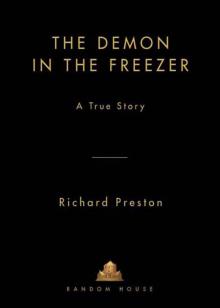 The Demon in the Freezer
The Demon in the Freezer Panic in Level 4: Cannibals, Killer Viruses, and Other Journeys to the Edge of Science
Panic in Level 4: Cannibals, Killer Viruses, and Other Journeys to the Edge of Science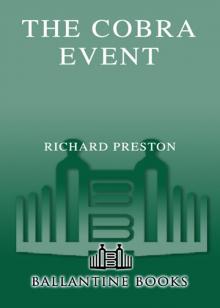 The Cobra Event
The Cobra Event The Hot Zone
The Hot Zone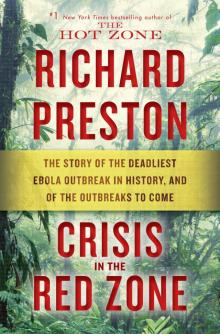 Crisis in the Red Zone
Crisis in the Red Zone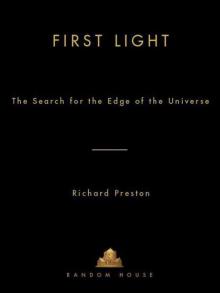 First Light: The Search for the Edge of the Universe
First Light: The Search for the Edge of the Universe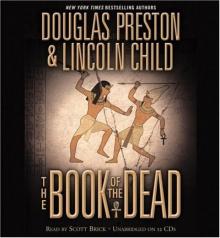 The Book of the Dead
The Book of the Dead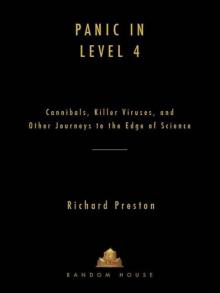 Panic in Level 4
Panic in Level 4